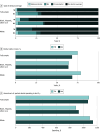Dental Coverage and Care When Transitioning From Medicaid to Medicare
- PMID: 39576614
- PMCID: PMC11584926
- DOI: 10.1001/jamahealthforum.2024.4165
Dental Coverage and Care When Transitioning From Medicaid to Medicare
Erratum in
-
Error in Introduction and Figure 1.JAMA Health Forum. 2024 Dec 6;5(12):e245090. doi: 10.1001/jamahealthforum.2024.5090. JAMA Health Forum. 2024. PMID: 39705047 Free PMC article. No abstract available.
Abstract
Importance: Millions of adults with low incomes lose Medicaid eligibility when transitioning to Medicare at age 65 years. However, it remains unclear how this transition is associated with dental care.
Objective: To examine the consequences of transitions from Medicaid to Medicare on coverage and use of dental services.
Design, setting, and participants: Cross-sectional data from the Health and Retirement Study from 2014 to 2020 and a regression discontinuity design were used to compare changes in outcomes before and after turning age 65 years among a population likely to be Medicaid-eligible before age 65 years. The sample included adults aged 50 to 90 years who had not attended college in 28 states.
Exposure: Transitions from Medicaid to Medicare at age 65 years.
Main outcomes and measures: Health insurance (Medicaid, Medicare, dual coverage, private, and uninsurance), dental coverage (Medicaid, Medicare, private, or none), and having a dental visit and out-of-pocket dental spending during the previous 2 years.
Results: Of the 15 837 study participants, 9510 (56.2% weighted) were female, 6984 (28.7% weighted) were Black individuals, Hispanic individuals, and individuals of other race (including American Indian, Alaskan Native, Asian, Native Hawaiian, and Pacific Islander individuals), and 8853 (71.3% weighted) were White; the mean (SD) age was 69.2 (10.3) years. Turning age 65 years was associated with an increase in Medicare coverage in states with Medicaid dental benefits (66.5 percentage points [pp]; 95% CI, 58.3-74.7) and those without dental benefits (67.8 pp; 95% CI, 52.6-83.0). There was a concurrent reduction in private coverage, Medicaid, and uninsured rates. For dental outcomes, in states providing Medicaid dental benefits, turning age 65 years was associated with a 13.1-pp decrease in the likelihood of dental coverage (95% CI, 10.7-15.5), largely due to the loss of Medicaid dental coverage. Among adults reporting being Black, Hispanic, or other race, there was a 3.9-pp decline in dental visits during the previous 2 years (95% CI, -6.1 to -1.7). In states without Medicaid dental benefits, turning age 65 years was associated with no change in the likelihood of dental coverage and a 15.6-pp increase in dental visits (95% CI, 6.3-25.0). Out-of-pocket dental spending decreased in both groups of states (-13.0% [95% CI, -24.2 to -0.1] and -19.2% [95% CI, -33.6 to -1.6], respectively).
Conclusions and relevance: The results of this cross-sectional study suggest that transitioning from Medicaid to Medicare at age 65 years was associated with a lower level of dental coverage and may increase barriers to accessing dental care for beneficiaries who had Medicaid dental coverage before age 65 years. However, for adults living in states without Medicaid dental benefits, the transition was associated with increased use of dental services and no change in overall dental coverage rates.
Conflict of interest statement
Figures



References
MeSH terms
LinkOut - more resources
Full Text Sources
Medical
Miscellaneous

